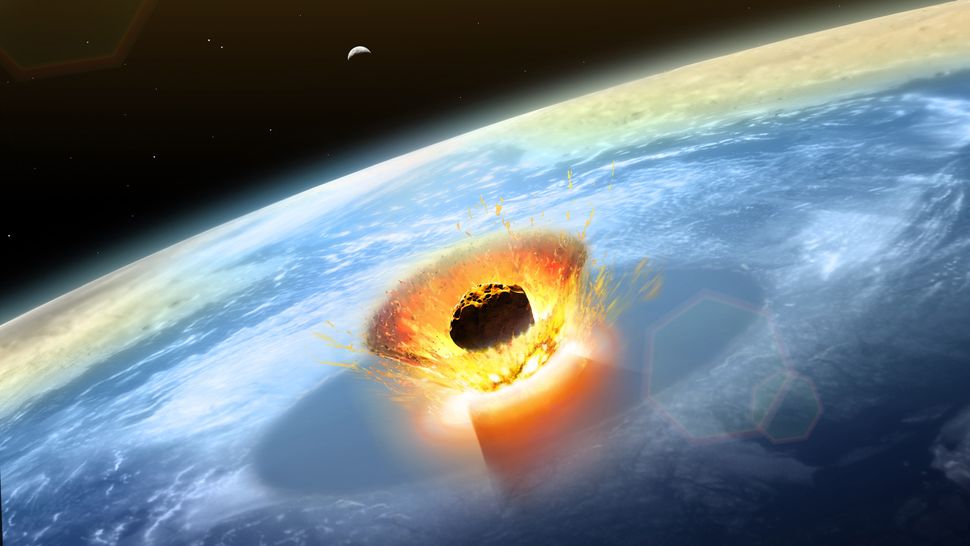
Posted on 08/09/2021 12:17:03 PM PDT by Red Badger

About 66 million years ago, an estimated 6-mile-wide (9.6 kilometers) object slammed into Earth, triggering a cataclysmic series of events that resulted in the demise of non-avian dinosaurs.
Now, scientists think they know where that object came from.
According to new research, the impact was caused by a giant dark primitive asteroid from the outer reaches of the solar system's main asteroid belt, situated between Mars and Jupiter. This region is home to many dark asteroids — space rocks with a chemical makeup that makes them appear darker (reflecting very little light) compared with other types of asteroids.
"I had a suspicion that the outer half of the asteroid belt — that's where the dark primitive asteroids are — may be an important source of terrestrial impactors," said David Nesvorný, a researcher from the Southwest Research Institute in Colorado, who led the new study. "But I did not expect that the results [would] be so definitive," adding that this might not be true for smaller impactors.
Clues about the object that ended the reign of non-avian dinosaurs have previously been found buried in the Chicxulub crater, a 90-mile-wide (145 km) circular scar in Mexico's Yucatan Peninsula left by the object's collision. Geochemical analysis of the crater has suggested that the impacting object was part of a class of carbonaceous chondrites — a primitive group of meteorites that have a relatively high ratio of carbon and were likely made very early on in the solar system's history.
(Excerpt) Read more at livescience.com ...
And all the rocks that dust was made from are only 4.51 billion years old proved by Apollo 14.
I don’t know where you sourced that, but it is completely illogical and irrational. Impossible that the dust is younger than the rocks that dust came from.
https://duckduckgo.com/?t=lm&q=How+old+are+moon+rocks%3F&ia=web
Every month, a new theory.
In before the Far Side cartoon.
Presenter: You have a new theory about the brontosaurus.
Miss Elk: Can I just say Chris for one moment that I have a new theory about
the brontosaurus.
Presenter: Exactly. (he gestures but she does not say anything) What is it?
Miss Elk: Where? (looks around)
Presenter: No, no your new theory.
Miss Elk: Oh, what is my theory?
Presenter: Yes.
Miss Elk: Oh what is my theory that it is. Well Chris you may well ask me what is my theory.
Presenter: I am asking.
Miss Elk: Good for you. My word yes. Well Chris, what is it that it is - this theory of mine. Well, this is what it is - my theory that I have, that is to
say, which is mine, is mine.
Presenter: (beginning to show signs of exasperation) Yes, I know it’s yours, what is it?
Miss Elk: Where? Oh, what is my theory? This is it. (clears throat at some
length) My theory that belongs to me is as follows. (clears throat at great
length) This is how it goes. The next thing I’m going to say is my theory.
Ready?
Presenter: Yes.
Miss Elk: My theory by A. Elk. Brackets Miss, brackets. This theory goes as
follows and begins now. All brontosauruses are thin at one end, much, much
thicker in the middle and then thin again at the far end. That is my theory,
it is mine, and belongs to me and I own it, and what it is too.
Presenter: That’s it, is it?
Miss Elk: Spot on, Chris.
Presenter: Well, er, this theory of yours appears to have hit the nail on the head.
Miss Elk: And it’s mine.
Presenter: Yes, thank you very much for coming along to the studio. Thank you.
Which brings us back to my original speculation from #6, that perhaps the event lowered the atmospheric oxygen level below what dinosaurs could survive on.
That seems plausible to me.
I have not seen any good research on oxygen levels at that period, but it seems plausible it was higher than it is now.
The level of CO2 could have been higher as well, which would promote more plant growth.
giant dark primitive asteroid
I am glad it was not a modern intelligent asteroid or it could have been worse.
Thermal forces? Someone is going to have to explain what that is.
Well, I guess it's possible that, if frozen gases on were exposed to direct sunlight, the thermal energy might be enough to cause the frozen gases to thaw enough for it to act as a "rocket exhaust" and launch it out of the belt, where gravitational forces would take over ...
I'm not a scientist (mad or otherwise), although I have played one on the stage ...
Heretic!!
You need a good bleeding.
Steve Martin as Theodoric of York
Whatever you are smoking must be the good stuff.
Given our social issues these days, maybe it’s time to order up another one.
Sure they do.
:)
I think I’m going to Klandathu,
That’s really, really where I’m going to.
If I ever get out of here,
That’s what I’m gonna do.
K-k-k-k-k-Klandathu,
I think that’s where I’m going to.
If I ever get out of here,
I’m going to Klandathu...............................
Heat from the sun causes ice to sublimate on objects in the Kuiper belt and the small jets of the escaping vapors send the object on a death plunge into the sun’s gravity well..............
Plaster, composites used by combining other animal bones, resins.
There’s a dindurock joke here somewhere.
Disclaimer: Opinions posted on Free Republic are those of the individual posters and do not necessarily represent the opinion of Free Republic or its management. All materials posted herein are protected by copyright law and the exemption for fair use of copyrighted works.